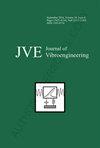基于自学习稀疏分解和特征模式分解的滚动轴承复合故障单通道盲源分离技术
IF 0.7
Q4 ENGINEERING, MECHANICAL
引用次数: 0
摘要
在单通道盲源分离(SCBSS)中,特征模式分解(FMD)比其他较新的时频方法(如集合经验模式分解(EEMD)和变异模式分解(VMD))更具优势。然而,FMD 有一个缺陷,即需要手动确定故障源的精确数量。为了解决 FMD 的上述缺陷,提出了一种基于移位不变稀疏码(SISC)的自适应方法来确定故障源的数量。利用 SISC 从单信道信号中训练出一组基函数,并首先重建相应的电位分量。然后,利用这些电位分量的结构相似性进行聚类,得到的每个聚类信号代表一种故障。然后,通过最小化聚类信号之间的结构相关性来确定聚类的数量。当聚类间的结构差异最大时,认为源分离达到了最佳效果,此时的聚类数量被作为最优估计值,并作为 FMD 计算模型的模态输入数,以实现滚动轴承的 SCBSS。通过仿真和实验分析验证了所提方法的有效性,并通过比较验证了其优越性。本文章由计算机程序翻译,如有差异,请以英文原文为准。
Single channel blind source separation of rolling bearing compound faults based on self-learning sparse decomposition and feature mode decomposition
Feature mode decomposition (FMD) has advantages over the other newer time-frequency methods such as ensemble empirical mode decomposition (EEMD) and variational mode decomposition (VMD) in single channel blind source separation (SCBSS). However, FMD has the defect of needing to determine the precise number of fault sources manually. To solve the above defect of FMD, an adaptive method for determining the number of fault sources based on the shift invariant sparse code (SISC) is proposed. SISC was used to train a set of basis functions from the single channel signal, and the corresponding potential components were reconstructed firstly. Subsequently, the structural similarity of these potential components was used for clustering, and each of the obtained clustering signals represented one kind of fault. Then the number of clustering was determined by minimizing the structural correlation among the clustering signals. It was considered that the source separation had achieved the best effect when the structural difference among the clusters was the largest, and the number of clustering at this time was used as the optimal estimated value, which was used as the modal inputs number of FMD calculation model to realize SCBSS of rolling bearing. Simulation and experimental analysis were carried out to verify the effectiveness of the proposed method, and its superiority was also verified through comparison.
求助全文
通过发布文献求助,成功后即可免费获取论文全文。
去求助
来源期刊

Journal of Vibroengineering
工程技术-工程:机械
CiteScore
1.70
自引率
0.00%
发文量
97
审稿时长
4.5 months
期刊介绍:
Journal of VIBROENGINEERING (JVE) ISSN 1392-8716 is a prestigious peer reviewed International Journal specializing in theoretical and practical aspects of Vibration Engineering. It is indexed in ESCI and other major databases. Published every 1.5 months (8 times yearly), the journal attracts attention from the International Engineering Community.
 求助内容:
求助内容: 应助结果提醒方式:
应助结果提醒方式:


